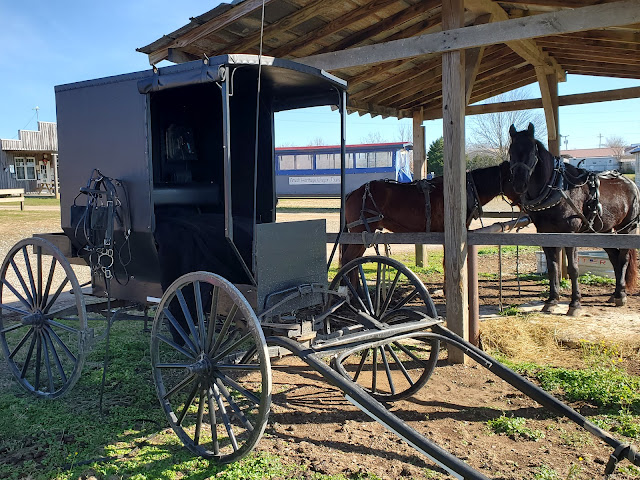In 1944, a small group of Swartzentruber Amish (one of the most conservative subgroups of Old Order Amish), left Mississippi and settled in Ethridge, Tennessee, for its good farmland. The area is now home to over 300 Amish families, and they welcome tourists to their homesteads to shop their goods (but they ask that you do not take any photos; their religion prohibits them from drawing attention to themselves). You can drive around the area on your own and/or take a wagon tour provided by non-Amish businesses. Pick up a map at one of the welcome centers or just look for the hand-written signs in front of the homes. Watch out for buggies on the roads, especially away from the farms on the main roads!
One of Tennessee’s oldest Amish farms (1944) is now the Amish Heritage Farm Museum. (Call before going. It was closed when we went, even though their website said it should be open.) This is a non-Amish business and you can take photos here. Even with it closed, you can still see some of it. Admission to the museum includes a horse drawn wagon tour through the Amish area.
Confusingly, there are two businesses called Amish welcome centers located almost next to each other on Highway 43. Tickets to the Amish Heritage Farm Museum are only available at the “Amish Heritage Welcome Center” (4001 Hwy 43). You can also shop and take a horse drawn wagon tour from “The Amish Welcome Center” (3943 Hwy 43), which is what we did since the other one was closed. The tours go out as people show up. We had just two of us for our tour and took a small, covered wagon. On a previous visit, as part of a large group, I rode in a much larger wagon. The tours include stopping at several of the farms and last about an hour and a half.
There are several one-room schoolhouses in the community. The children running around and playing outside their schoolhouses make a scene that looks like a 19th-century painting (I wish I could have taken a photo). The teachers are young, unmarried girls who have completed 8th grade (Amish education ends at 8th grade). You can see “his and hers” outhouses beside the schools. The Amish hold church in their homes, so there are no church buildings.
Most families have many children (our tour guide said nine children on average, but some have up to twenty). When the parents get old they sell their farm to one of the children who then builds a new house (sometimes connected to the parents’ house) and the parents stay in their old house.
They don’t have cars, tractors, electricity, or running water. They don’t use pneumatic or hydraulic power in their shops, but I was surprised to see that they do use single shaft diesel engines to run shop equipment (such as in a furniture making shop).
You can find all sorts of items for sale, such as soaps, candles, wooden furniture, candy (including the best peanut brittle ever), quilts, leather goods, rugs, baskets, jams & jellies, pickled foods, and more. The prices are better at the homesteads than at the stores on the highway selling Amish goods. The Amish only take cash though. (There is an ATM inside the Amish Welcome Center.) The homesteads also have honor boxes for payment if no one is available. I bought this beautiful cutting board for less than half the price I've seen similar cutting boards elsewhere, and I got to meet the teenage boy who made it (he signs and dates them on the back). I also bought a biscuit cutter and rolling pin.
Stop in at Bob’s Café for lunch (between the two welcome centers). The food is great and the people are so nice. There are several restaurants and plenty of antique stores and markets along highway 43.













